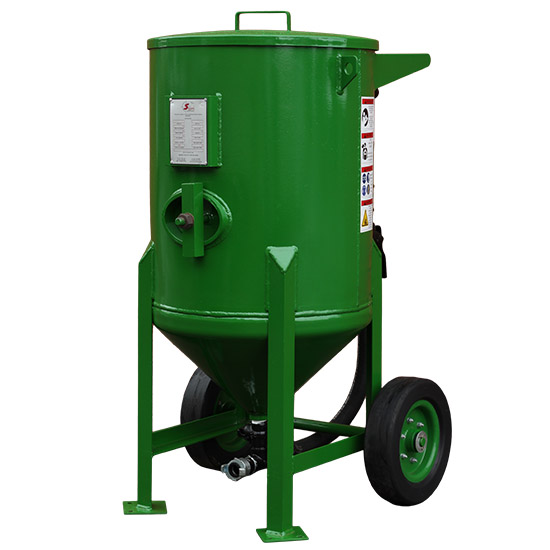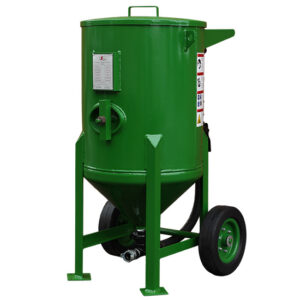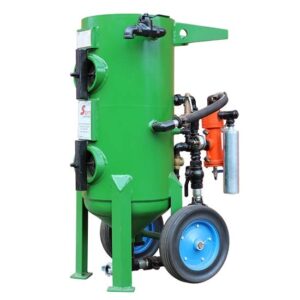All abrasive blast pots conform to the regulations under Section 44 of the Occupational Health and Safety Act 1993 (Act No. 85 of 1993) as categorized in terms of SANS 347 requirements.
Blast pot log book includes:
- Hydro-static pressure test certificate
- Certified safety blow-off valve
- Certified pressure gauge
Dry Blast Pots
Dry blast pots provide the most economic, convenient and manageable form of abrasive blasting and can be used for a variety of industrial and commercial applications.
Sizes & Specifications
Available in the following sizes:
Single Chamber | 60L BLast Pot | 100L Blast Pot | 200L Blast Pot |
 |  |  | |
Diameter | 360 mm | 510 mm | 615 mm |
Height | 1,015 mm | 1,040 mm | 1,305 mm |
Length | 620 mm | 770 mm | 830 mm |
Width | 560mm | 630 mm | 730 mm |
Weight | 95 kg | 140 kg | 214 kg |
Blast Nozzle | 6.5 / 8 / 9.5 / 11 / 12.5 mm | 6.5 / 8 / 9.5 / 11 / 12.5 mm | 6.5 / 8 / 9.5 / 11 / 12.5 mm |
Blast Hose | 13 / 19 / 25 mm | 25 / 32 mm | 32 / 38 mm |
Nozzle Selection
(Incl. helmet air)
Nozzle Size | 6.5 mm | 8 mm | 9.5 mm | 11 mm | 12.5 mm |
Approximate CFM | 100 CFM | 150 CFM | 215 CFM | 270 CFM | 335 CFM |
Learn more about our blast nozzles
Learn more about our blast hose
Advantages
Simple pneumatic setup ensures easy operation.
Pots are robust, mobile and can be easily moved and re-located.
All pots are pressure tested and manufactured with only high quality materials ensuring safety and reliability.
Remote vs. Manual Blast Pots
1. Remote Blast Pots
Remote blast pots require only 1 operator. A remote control valve and deadmans handle are installed in remote blast pots. This allows a single operator to start the compressor, fill the blast pot and, when ready, proceed to start/stop the blast pot by pressing down and releasing the deadmans handle.
Remote blast pots contain more working parts than manual blast pots and may require additional spare parts and maintenance.
2. Manual Blast Pots
Manual blast pots require 2 operators. This includes a blast pot operator and a blast nozzle operator. The blast pot operator operates the physical settings of the blast pot (i.e. start compressor/fill pot/start & stop operation of pot), while the nozzle operator will perform the physical task of abrasive blasting (according to the specific job/application).
Because manual blast pots have fewer working parts (i.e. manual valves) they require an additional operator.




